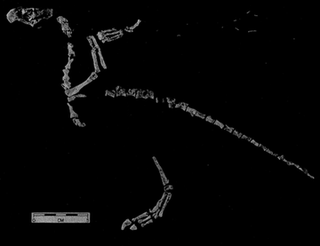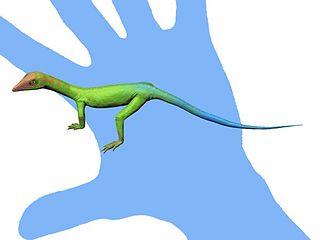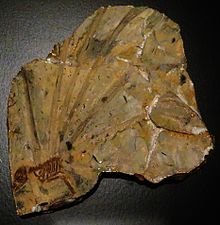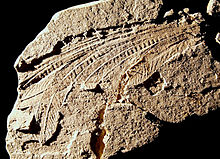
Protoavis is a problematic taxon known from fragmentary remains from Late Triassic Norian stage deposits near Post, Texas. The animal's true classification has been the subject of much controversy, and there are many different interpretations of what the taxon actually is. When it was first described, the fossils were described as being from a primitive bird which, if the identification is valid, would push back avian origins some 60-75 million years.

A feathered dinosaur is any species of dinosaur possessing feathers. That includes all species of birds, but there is a hypothesis that many, if not all, non-avian dinosaur species also possessed feathers in some shape or form. That theory has been challenged by some research.

Archosauriformes is a clade of diapsid reptiles encompassing archosaurs and some of their close relatives. It was defined by Jacques Gauthier (1994) as the clade stemming from the last common ancestor of Proterosuchidae and Archosauria. Phil Senter (2005) defined it as the most exclusive clade containing Proterosuchus and Archosauria. Archosauriforms are a branch of archosauromorphs which originated in the Late Permian and persist to the present day as the two surviving archosaur groups: crocodilians and birds.

Tanystropheus is an extinct genus of archosauromorph reptile which lived during the Triassic Period in Europe, Asia, and North America. It is recognisable by its extremely elongated neck, longer than the torso and tail combined. The neck was composed of 13 vertebrae strengthened by extensive cervical ribs. Tanystropheus is one of the most well-described non-archosauriform archosauromorphs, known from numerous fossils, including nearly complete skeletons. Some species within the genus may have reached a total length of 6 meters (20 ft), making Tanystropheus the longest non-archosauriform archosauromorph as well. Tanystropheus is the namesake of the family Tanystropheidae, a clade collecting many long-necked Triassic archosauromorphs previously described as "protorosaurs" or "prolacertiforms".

Scansoriopteryx is a genus of maniraptoran dinosaur. Described from only a single juvenile fossil specimen found in Liaoning, China, Scansoriopteryx is a sparrow-sized animal that shows adaptations in the foot indicating an arboreal (tree-dwelling) lifestyle. It possessed an unusual, elongated third finger which may have supported a membranous wing, much like the related Yi qi. The type specimen of Scansoriopteryx also contains the fossilized impression of feathers.

Sharovipteryx is a genus of early gliding reptiles containing the single species Sharovipteryx mirabilis. It is known from a single fossil and is the only glider with a membrane surrounding the pelvis instead of the pectoral girdle. This lizard-like reptile was found in 1965 in the Madygen Formation, Dzailauchou, on the southwest edge of the Fergana Valley in Kyrgyzstan, in what was then the Asian part of the U.S.S.R. dating to the middle-late Triassic period. The Madygen horizon displays flora that put it in the Upper Triassic. An unusual reptile, Longisquama, was also found there.

Avicephala is a potentially polyphyletic grouping of extinct diapsid reptiles that lived during the Late Permian and Triassic periods characterised by superficially bird-like skulls and arboreal lifestyles. As a clade, Avicephala is defined as including the gliding weigeltisaurids and the arboreal drepanosaurs to the exclusion of other major diapsid groups. This relationship is not recovered in the majority of phylogenetic analyses of early diapsids and so Avicephala is typically regarded as an unnatural grouping. However, the clade was recovered again in 2021 in a redescription of Weigeltisaurus, raising the possibility that the clade may be valid after all.

Aleksandr Grigorevich Sharov was a Soviet palaeoentomologist, paleontologist and expert on Pterosauria. He graduated from Moscow State University. In 1951 he defended Candidate of Science dissertation on the embryology of Apterygota. Since 1951 he worked at the Paleontological Institute in Moscow, where in 1966 he defended dissertation of Doctor of Science. His major contribution to the phylogeny of Arthropods was published in 1966. He worked during the 1960s and 1970s on the Karatau rocks and discovered many of the fossils, of which some have been named after him, as in the case of the Karatausuchus sharovi, and Sharovipteryx. He also discovered and described the specimen Sordes pilosus in 1971 and Longisquama insignis.

Avemetatarsalia is a clade of diapsid reptiles containing all archosaurs more closely related to birds than to crocodilians. The two most successful groups of avemetatarsalians were the dinosaurs and pterosaurs. Dinosaurs were the largest terrestrial animals for much of the Mesozoic Era, and one group of small feathered dinosaurs has survived up to the present day. Pterosaurs were the first flying vertebrates and persisted through the Mesozoic before dying out at the Cretaceous-Paleogene (K-Pg) extinction event. Both dinosaurs and pterosaurs appeared in the Triassic Period, shortly after avemetatarsalians as a whole. The name Avemetatarsalia was first established by British palaeontologist Michael Benton in 1999. An alternate name is Pan-Aves, or "all birds", in reference to its definition containing all animals, living or extinct, which are more closely related to birds than to crocodilians.

The scientific question of within which larger group of animals birds evolved has traditionally been called the "origin of birds". The present scientific consensus is that birds are a group of maniraptoran theropod dinosaurs that originated during the Mesozoic Era.

Drepanosaurs are a group of extinct reptiles that lived between the Carnian and Rhaetian stages of the late Triassic Period, approximately between 230 and 210 million years ago. The various species of drepanosaurid were characterized by specialized grasping limbs and often prehensile tails, adaptions for arboreal (tree-dwelling) and fossorial (digging) lifestyles, with some having also been suggested to be aquatic. Fossils of drepanosaurs have been found in Arizona, New Mexico, New Jersey, Utah, England, and northern Italy. The name is taken from the family's namesake genus Drepanosaurus, which means "sickle lizard," a reference to their strongly curved claws.

John Alan Feduccia is a paleornithologist specializing in the origins and phylogeny of birds. He is S. K. Heninger Distinguished Professor Emeritus at the University of North Carolina. Feduccia's authored works include three major books, The Age of Birds, The Origin and Evolution of Birds, Riddle of the Feathered Dragons,.
John A. Ruben is a researcher in Zoology and Vertebrate paleontology at the Oregon State University in Corvallis. Much of his published research is focused on studying the respiratory system in birds, in order to contradict the theory of theropodan ancestry of birds, as well as their metabolism.
Praeornis is a dubious genus of early avialan or bird-like dinosaur, named on the basis of a single feather discovered in the Karabastau Formation of Kazakhstan by Sharov in 1971. A second specimen was discovered in 2010 by Dzik et al. The feathers of Praeornis likely represent modified tail feathers used for display or balance, similar to those found in some other early avialans. The feathers of Praeornis are unique thanks to their extremely thick central quill (rachis) and stiffened barbs.

Reptiles arose about 320 million years ago during the Carboniferous period. Reptiles, in the traditional sense of the term, are defined as animals that have scales or scutes, lay land-based hard-shelled eggs, and possess ectothermic metabolisms. So defined, the group is paraphyletic, excluding endothermic animals like birds that are descended from early traditionally-defined reptiles. A definition in accordance with phylogenetic nomenclature, which rejects paraphyletic groups, includes birds while excluding mammals and their synapsid ancestors. So defined, Reptilia is identical to Sauropsida.

Cosesaurus is a genus of archosauromorph reptiles likely belonging to the family Tanystropheidae. It is known from fossil imprints of a single small skeleton, MGB V1, which was found in Muschelkalk outcrops near the municipalities of Mont-ral and Alcover in Spain. These outcrops are dated to the Ladinian age of the middle Triassic about 242 to 237 million years ago. The specimen is stored at the Museu Martorell, which is now part of the Museu de Ciències Naturals de Barcelona. The poor preservation and likely juvenile nature of the specimen has led to the anatomy of Cosesaurus being misidentified by several different sources. For example, Paul Ellenberger claimed that it was an ancestor to birds in the 1970s, while David Peters claimed that it was a pterosaur ancestor in 2000. Both of these claims contrast with mainstream scientific theories on the origins of either group, and other paleontologists who study the specimen are unable to find the features which Ellenberger or Peters reported to be present. The Ellenberger and Peters hypotheses are thus considered fringe theories with questionable scientific soundness due to their low reproducibility. Mainstream hypotheses for the relations of Cosesaurus generally agree that it is a "protorosaur", specifically a tanystropheid closely related to long-necked reptiles such as Macrocnemus, Tanytrachelos, Tanystropheus, or Langobardisaurus.
The Madygen Formation is a Late Triassic (Carnian) geologic formation and Lagerstätte in the Batken and Osh Regions of western Kyrgyzstan, with minor outcrops in neighboring Tajikistan and Uzbekistan. The conglomerates, sandstones and mudstones of the 560 m (1,840 ft) thick formation were deposited in terrestrial lacustrine, alluvial, fluvial and deltaic environments.

The Origin of Birds is an early synopsis of bird evolution written in 1926 by Gerhard Heilmann, a Danish artist and amateur zoologist. The book was born from a series of articles published between 1913 and 1916 in Danish, and although republished as a book it received mainly criticism from established scientists and got little attention within Denmark. The English edition of 1926, however, became highly influential at the time due to the breadth of evidence synthesized as well as the artwork used to support its arguments. It was considered the last word on the subject of bird evolution for several decades after its publication.
Boreopricea is an extinct genus of archosauromorph reptile from the Early Triassic of arctic Russia. It is known from a fairly complete skeleton discovered in a borehole on Kolguyev Island, though damage to the specimen and loss of certain bones has complicated study of the genus. Boreopricea shared many similarities with various other archosauromorphs, making its classification controversial. Various studies have considered it a close relative of Prolacerta, tanystropheids, both, or neither. Boreopricea is unique among early archosauromorphs due to possessing contact between the jugal and squamosal bones at the rear half of the skull.

Triassurus is an extinct genus of amphibian, and the oldest member of Caudata. It is known from the Middle to Upper Triassic (Ladinian-Carnian) aged Madygen Formation in Kyrgyzstan. The type species is T. sixtelae.



























